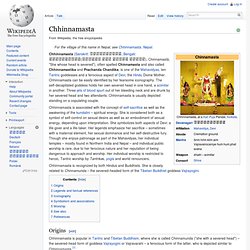

Piano Bench with Quilted Seat Cushion-13981-400-21. Chhinnamasta. Chhinnamasta (Sanskrit: छिन्नमस्ता, Bengali: ছিন্নমস্তা(অর্থাৎ যার মস্তক ছিন্ন), Chinnamastā, "She whose head is severed"), often spelled Chinnamasta and also called Chhinnamastika and Prachanda Chandika, is one of the Mahavidyas, ten Tantric goddesses and a ferocious aspect of Devi, the Hindu Divine Mother.

Chhinnamasta can be easily identified by her fearsome iconography. The self-decapitated goddess holds her own severed head in one hand, a scimitar in another. Three jets of blood spurt out of her bleeding neck and are drunk by her severed head and two attendants. Chhinnamasta is usually depicted standing on a copulating couple. Chhinnamasta is associated with the concept of self-sacrifice as well as the awakening of the kundalini – spiritual energy. Chhinnamasta is recognized by both Hindus and Buddhists. Origins[edit] Buddhist texts recount the birth of the Buddhist Chinnamunda. The Buddhist Chinnamunda is believed to be the antecedent of the Hindu Chhinnamasta. The scholar B. Chhinnamasta. Muraqaba. Muraqaba (Arabic: مراقبة) is the Sufi word for meditation.

Literally it is an Arabic term which means "to watch over", "to take care of", or "to keep an eye". It implies that with meditation, a person watches over or takes care of his spiritual heart (or soul), and acquires knowledge about it, its surroundings, and its creator.[1] Stages of Muraqaba[edit] Somnolence[edit] This is the starting level of meditation. Adraak[edit] (Arabic: إدراك - cognition) With continuous practice of meditation, the sleepiness from meditation decreases. Warood[edit] (Arabic: ورود coming, beginning) When adraak (experience) becomes deep, it is exhibited as sight.
Gnosis of the universe[edit] Kashaf' / Ilhaam[edit] Kashaf, or Ilhaam (Arabic: كشف/الهام unveiling of arcane knowledge) is the stage where man starts getting information that most people are unable to observe. Shahood[edit] Fatah[edit] (Arabic: فتح opening, victory) The peak of Shahood is called Fatah. Gnosis of Allah[edit] Fanaa[edit] Sair illallah[edit] Unurthed. A Navajo sand painting, New Mexico, c. 1950, dissected in Joseph Campbell‘s The Inner Reaches of Outer Space, 1986.

Such paintings, composed of colored sand strewn upon a hogan’s dirt floor, are used in healing and initiation ceremonies, wherein an assemblage of friends and neighbors chant and encourage an initiate, physically entering the painting, to [re]embark upon and [re]live a mythic adventure. Starting at the bottom, “the footprints represent a spiritual ascent along the mystic way known to the Najaho as the Pollen Path” (p93). “The two colors of the ‘female’ and the ‘male,’ lunar and solar powers… become one on passing between the guardian Spirit Bringers at the entrance to the sanctuary; the path, which is now of the single color of pollen, runs to the base of the World Tree, where three roots or ways of entrance are confronted” (p97).
“The ordeal is an act of sacrifice. Animal-Cat-Lion-eating-sun. Lion < Lion of judah.